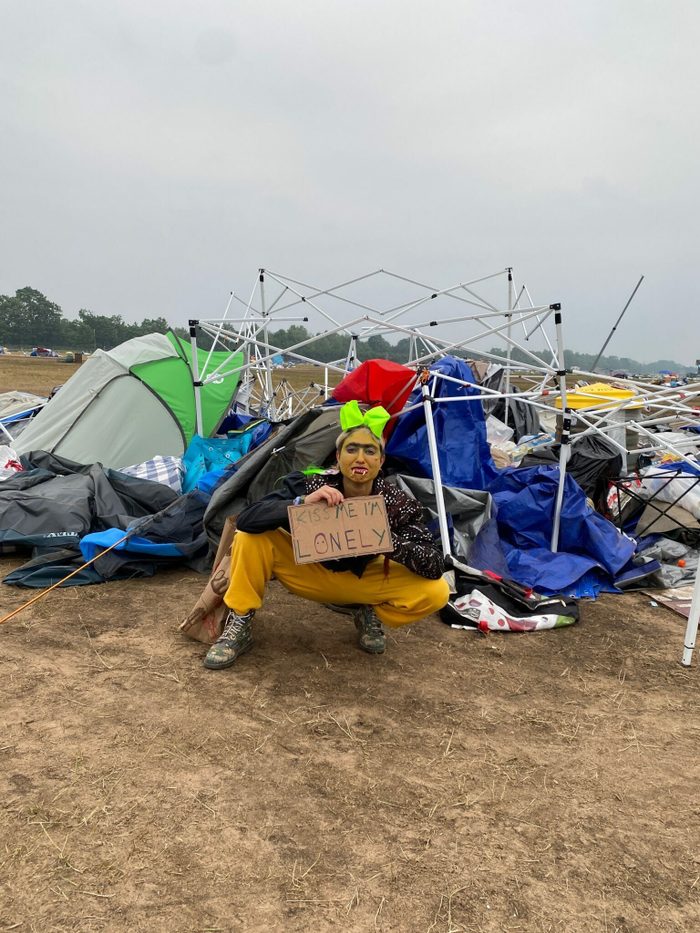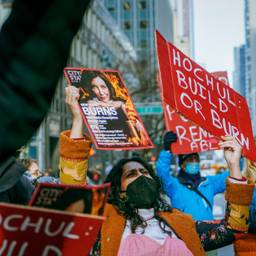No Parties on a Dead Planet: It’s Time We Reimagine Burning Man
Why this ecologically devastating escapist drug party just hits differently in 2023.
Corinne Loperfido

For the past 37 years, people have flocked to Burning Man to celebrate art, radical self expression and community. The first iteration of Burning Man began in 1986 when a small group of friends met on a San Francisco beach with an eight-foot statue of a man they built with scrap lumber. They soaked the statue in gasoline and burned it, symbolizing the destruction of the powers that be.
The world does not look today as it did in 1986: As about 72,000 “Burners” lined up in their cars and campers to take reprieve from the grind of capitalism and attend this year’s Burning Man, which now convenes in Nevada’s Black Rock Desert, a group of climate activists from Seven Circles Alliance blocked the road, igniting a clash between activists, Burners and tribal rangers, including one who drove his vehicle through the activists’ blockade and threatened protestors with his gun.
Displaying a banner that read “Ban Private Jets,” these climate activists also called for a ban on “single use plastics, unnecessary propane burning and unlimited generator use per capita” at one of the biggest global parties of the year. Their concerns seem warranted. According to the Washington Post:
Burning Man Project, a San Francisco-based non-profit organization that runs the annual event, estimated that more than 54,200 metric tons of CO2 was released by the festival in 2019, the equivalent of burning 27,215 metric tons of coal. Black Rock Labs, a non-profit tech incubator, puts the figure at 100,000 tons. Some 91% of that is from transporting 80,000 people and equipment into and out of the desert. That’s largely cars and recreational vehicles, but it’s also planes. Attendees visit from more than 5,500 cities across the world and the event sets up its own airport, so tech and finance bros can swing by on private jets. On-site emissions are inflated by the air-conditioned tents and RVs providing respite from the oppressive desert heat often felt in normal years.
Many Burners justify their attendance to the festival by using solar panels and lithium ion batteries instead of gas generators to power their camps, but local indigenous tribes have been fighting to protect the nearby land at Thacker Pass, where the largest open-pit lithium mine in the country is slated for expansion, further degrading the land, air and water quality. How do the local people’s struggle over resource extraction in the same desert play into the so-called “civic responsibility” Burning Man’s official website lists as one of its 10 principles?
But the festival raged on for this year’s eager partygoers with disposable income and ample time to be able to dedicate weeks (or months) of their lives going to these massive festivals each year.
“Radical self reliance” as another one of Burning Man’s 10 principles, but there is nothing “self reliant” about the resources Burners rely on for the nine day party, including the fossil fuels needed to run their big RVs and air-conditioned orgy domes, the lithium ion batteries required for their solar panels, the massive lines and empty shelves at Walmart as people stock up before these events, and the unfettered extraction and exploitation that the attendees continue to support via fast fashion, single use art and single use plastics from companies like Amazon and Costco.
Putting on an ecologically devastating escapist drug party just hits differently in 2023. The humble eight-foot man statue made of scrap lumber is no more — the statue reached a record height of 105 feet in 2014 and 2017. In addition, Burning Man uses new resources to build and burn the man every year, somehow justifying the continual burning of limited resources and supporting the logging industry when there’s fewer and fewer trees left to cut down because of overuse and wastefulness.
Let’s also address the literal mountains of trash that surround Burning Man in the small towns right outside the nearest exits. Another Burning Man principle states a commitment to “leaving no trace,” but the idea that people somehow think they are “leaving no trace” by dropping their stinky garbage bags at the nearest overflowing dumpster is laughable. What about the low paid workers that have to empty those dumpsters in the small towns near Black Rock City, while the privileged (mostly white) middle and upper class folks who created the mess fly home and post their reels on Instagram? Doesn’t really feel very “radically inclusive” to me.
For the past 13 years, I have been a part of the festival performance art and DIY event world. I have traveled all over the world, performing everywhere from the Sydney Opera House to filthy basement punk shows. I’ve literally seen and done it all, including attending Burning Man in 2015. What I know for sure today, is that it is time for business as usual to come to a halt so we can reassess our global priorities. As an artist and performer, I have deep gratitude for the arts and culture that Burning Man has inspired over the years AND I do not support the continued exploitation of Earth’s resources that is being perpetrated in the name of “fun and whimsy.” There is no party on a dead planet and at this rate, we won’t last very many more years. I am not proposing that all gatherings must end and fun gets canceled, but I am calling for people to focus their resources and attention locally and take the inspiration and principles of Burning Man into their own communities instead of flying and driving all over our burning Earth to go get high and have sex with strangers in a tent that they are going to abandon days later in the desert.

This isn’t just about Burning Man though — this goes for nearly all large festivals. This summer I was hired to perform at a festival in Rothbury, Mich. called Electric Forest. What I found in this forest was no animals, no birds or bees, but instead endless piles of litter in the form of stickers and glow sticks, plastic face jewels and single use water bottles. What kind of “community care” is it to not have a single functional hand washing station for the rows of port-a-potties at a massive gathering in the age of Covid? What kind of “community standards” are we living when the camping fields are filled with thousands of abandoned tents, tarps, rave sticks and muddy shoes at the end of the party? There is no such thing as away and the words “Happy Forest!” being said with a smile by festival goers passing each other on the path, made me deeply depressed as I looked around at this extremely unhappy forest that was being subjected to deafening harsh electronic music, blasting fireworks and careless human beings leaving their garbage everywhere. I know everyone thought hard about what they were going to wear to the rave, but did any of them think about how the plants and animals are hurting and/or dying because of their presence?
If you’ve ever been to a festival or been curious to go, I invite you to reflect on the ways your choices perpetuate extractive capitalism. For all the fun that was had at these festivals over the years, we need to get real about their effects on the land today. I can appreciate the humble beginnings of how these massive gatherings began, but the point I am making is that we have a lot of work to do to clean up the mess we’ve made since Burning Man started in 1986.
Imagine if all the time and resources that went into traveling to these large festivals went into helping people rebuild their homes or cooking food for the homeless? What if people started taking pride and joy in how many acres of land they cleaned up with their friends? Think about ways we can give back to our Earth instead of just continuing to take and take, like cleaning up our local rivers and mulching the Earth instead of driving over the dusty ground and sending more particulate matter into the atmosphere. Action is the antidote to despair, and it’s time to get active on actually living the Burning Man principle of “communal effort,” instead of patting ourselves on the back for the amount of exploitation that we did. The jig is up! It’s the end of an era, and I look forward to seeing what we all cocreate as we work to redefine what community really is and find new pleasures in ways that focus more on giving than taking.
Corinne Loperfido is a social practice artist whose colorful, maximalist work spans visual and performance art, upcycled fashion and costume design, as well as community event production focused on women’s empowerment and environmental activism. She uses discarded resources to create new worlds where we value what we have and take care of the things that already exist instead of continuing to act as if our Earth is a bottomless pit for our consumption. She provokes cultural change at the same speed and scale of the numerous ecological and societal crises that confront us. www.corinneloperfido.com





